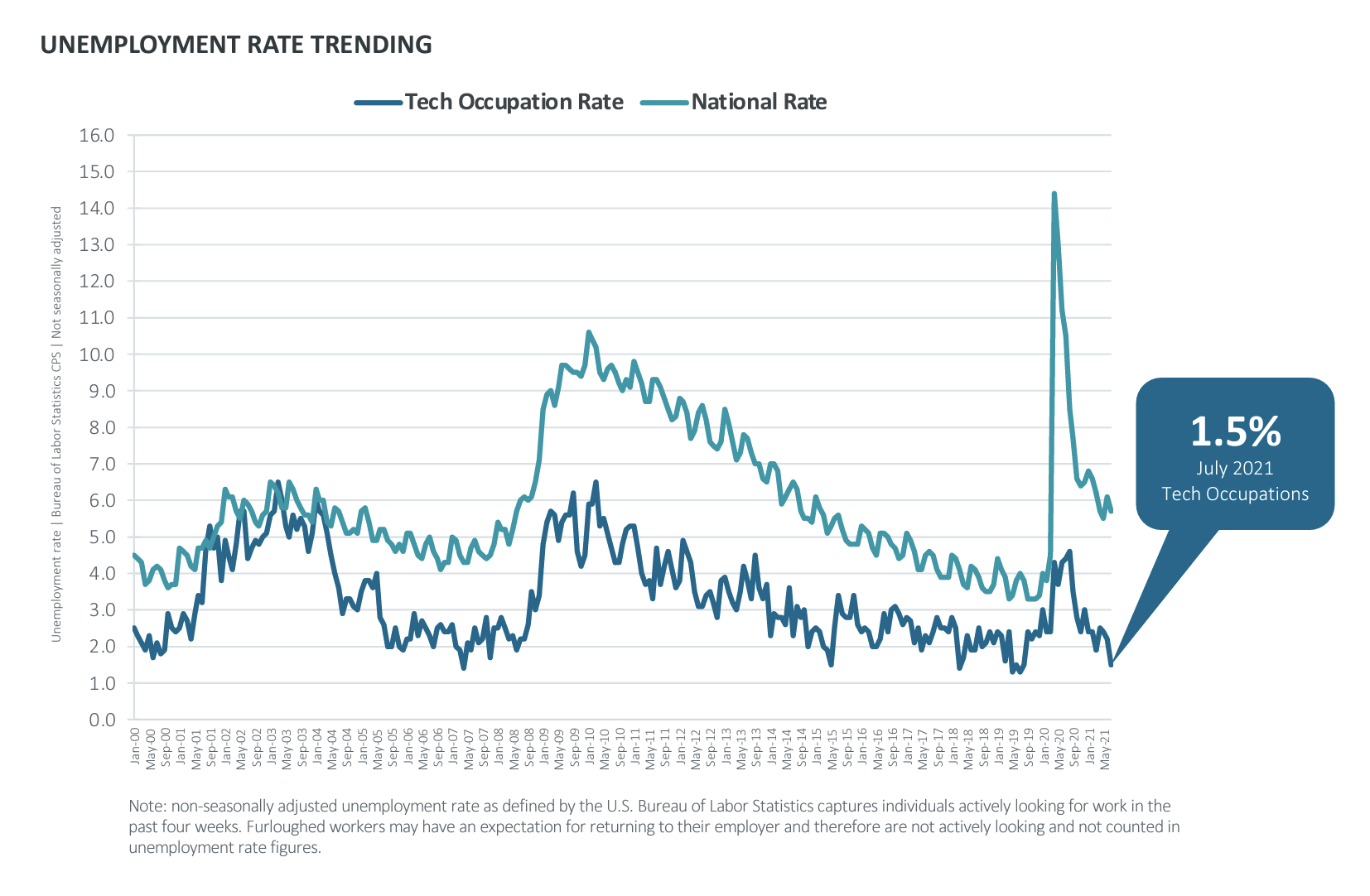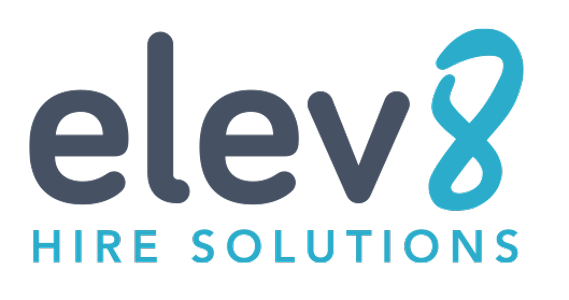
The New Hiring Practices You Need To Win Talent Today
With the global job market in high demand, hiring managers must be willing to change to be successful—particularly when hiring for technology jobs.
We have been in a flat-out labor shortage. As of July 2022, unemployment across tech occupations hit 1.7%, well below the national average of 3.5%, even with the concerns of a possible recession. For the most part, in tech, if you want a job—you already have one. Employers increasingly must turn to recruiting passive candidates, who are much more likely to take time to convince to move.

And if you think today is difficult to hire, the future is even more bleak. With growth in the tech market expected to be 11% through 2029, the additional 500,000+ tech jobs the Bureau of Labor & Statistics expects the US will only be harder to fill—if not impossible.
Compounding this, tech jobs notoriously take 70% longer to fill than most jobs. Today’s trends indicate the average time is well above 80 days. Many smart companies are realizing it is impractical to hire senior or specialized staff in this climate.
Instead, they are focusing on reducing friction in the hiring pipeline, hiring for aptitude and culture, and then investing to build the staff they need.
Nail the Candidate Experience
Candidates are flooded with opportunities right now in this ultra-competitive market. To stand out, a company needs to be organized, communicative and quick. Slow companies may find excellent candidates, but lose them before they can hire.
The candidate experience covers the full spectrum of interactions that a job seeker has with your company throughout the recruiting process. Covering everything from your job posting to your rejection letters and job offers, a positive experience should inspire the candidate, make them feel valued, and capitalize on their attention.
- Streamline your application process to 5 minutes or less. Streamlining your application process to five minutes or less can boost your application conversion rates by up to 365 percent, according to a study from AppCast.
- Move candidates through interview stages quickly. Move candidates through interview stages and communicate progress within 48 hours or faster. According to Top Echelon Network, 40 percent of candidates reject offers because someone else gave them an offer faster.
- Create a compelling career site & collateral. When built successfully, your career site can help boost the yield and quality of your direct hires.
- Organize your interview team. Before the first candidate comes through, ensure all interviewers know their expectations and bias for quick turn-arounds. Do all training and orientation before it impacts candidate experience.
- Use skills-based assessments. Digital assessments help lower fraud in your interview process while improving confidence in the candidate’s abilities, helping you to make hiring decisions faster and with better quality.
- Create standardized communication. Before the first candidate applies, be sure to plan out a cadence and content for communication so it is ready when needed.
- Surprise and delight! Stand out from your competition with a little extra effort like sending swag, hiring a car service for transport to an interview, or sending handwritten notes or personal video greetings. The extra charm shows you’ve got heart and may win you a new team member.
- Create personalized presentation packets for interviewing & job offers. These packets always impress candidates, while providing guidance and transparency.
The Value of Upskilling & Reskilling in Hiring
Finally, it is imperative that companies shift how they are writing their job descriptions. Historically companies look at pedigree for hiring. Where did the candidate go to school? Where did they work? How long were they there? And what software name brands have they used? These questions focus on what they have done, not their potential.
Instead, today we recommend skills based hiring.

Hiring someone with potential and investing in them can be significantly faster to hire, and increase the longevity of their employment.
The value of investing in your employees, of course, is universal to all workers, not just the under-skilled. People like people who take care of them. They create a stronger sense of loyalty to someone who took a chance on their passion and potential. Then they stay longer, and are more engaged—which is always better for business.
In fact, organizations that fill more than 25% of their middle-management positions with external hires have double the turnover of those who rely on internal promotion. And, according to some estimates, it can cost 33 percent of a departing employee’s salary to replace them—and even more in opportunity costs. So investing in employees is always a good idea.
Plus, by widening your criteria where it counts, you can substantially increase your candidate pool. For example, more than 2.5 million food service workers lost their jobs during the pandemic. More than 70% of them have the skills needed to succeed in customer service, which is currently one of the most in-demand jobs on LinkedIn. Had servers and people hiring for customer service specialists realized there was such potential, we would have had far less joblessness and better phone wait times over the past year.
This untapped pool of competent workers are known as STARs—employees who are Skilled Through Alternative Routes, rather than through four-year degrees—represents more than 70 million workers. STARs have diverse skills acquired through community college, certificates, hobbies, military or even on-the-job training, but are often overlooked due to arbitrary degree requirements.
Given the dearth of candidates today, increasingly business leaders like Google and Apple agree that these STARs must be part of the talent pool or their business growth will be stunted in the future. In fact, Google went so far as to create Google Career Certificates as a flexible, low cost way to up skill the entire workforce regardless if they work for Google. This is the quintessential rising tide that lifts all boats.
LinkedIn data seems to also prove this is worthwhile. A LinkedIn survey found employees without a traditional four-year degree stay at companies 34% longer than those who have one. Certainly, this could be based on a perception that it’s more difficult for them to find their next job, but it could also be a sign that they simply feel more cared for and are more grateful that their employer invested in their career. As LinkedIn’s 2018 Workplace Learning Report showed, 94% of employees said they would stay at a company longer if it invested in their career.
So, investing in building people is very good for the bottom line, and very necessary to navigate hiring in the long term.
What Does Skills-based Hiring Look Like Today?
Skills based hiring starts with rethinking how you write your job descriptions. Focus on what they can do — not where they’ve been— avoids creating an unnecessary barrier to entry, like a requirement for a four-year degree. This instantly taps into that wider and more diverse talent pool.

Next you’ll need a skills-based way to assess candidates and find your finalists. This means you need to construct ways to assess these skills, and find a tool to help you. From hard skill evaluations like coding tests to personality tests for soft skill assessments, there are plenty of ways to gauge a candidate’s capabilities without relying on their education or experience as proxies.
When you do perform assessments, look to get a quantitative score. Know the ranges or pass-fail threshold for each assessment, and use these scores to fail out candidates fast while progressing acceptable candidate just as quickly. Do not wait for more than 48 hours for other candidates—if you find someone acceptable, push them forward. Hire them. You may lose them if you wait, and you could end up costing your company more.
